If many users are to be deleted from a domain, deleting using the Web GUI may be time consuming and inefficient. In that case, Administrators can upload a spreadsheet containing the required data and delete the users. Follow these steps to delete users in bulk.
|
Sl No |
Description |
|
1 |
Create a spreadsheet in your favorite office suite. |
|
2 |
Enter data for one user in a single row. |
|
3 |
For each row, the columns should have the following data. There should be no header row. The first row should contain data of first user. Second row, data of second user and so on... |
|
4 |
Column 1: username Contains the email address of the user. Required. |
|
5 |
Save the Spreadsheet in Excel 97-2003 Workbook (*.xls) format. |
|
6 |
Make sure that the spreadsheet does not contain more than 1000 rows. If you need to create more than 1000 users, create multiple spreadsheets of 1000 users each. |
|
7 |
Once you are ready with the spreadsheet, proceed further |
|
8 |
Login to control panel |
|
9 |
That will bring up the following window  |
|
10 |
Click on Bulk Operations. That will bring up the following window 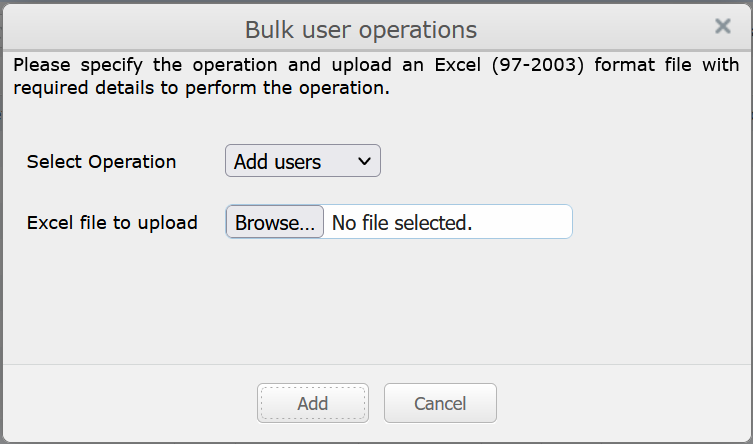 |
|
11 |
Choose Select Operation field as Delete Users. That will display the following 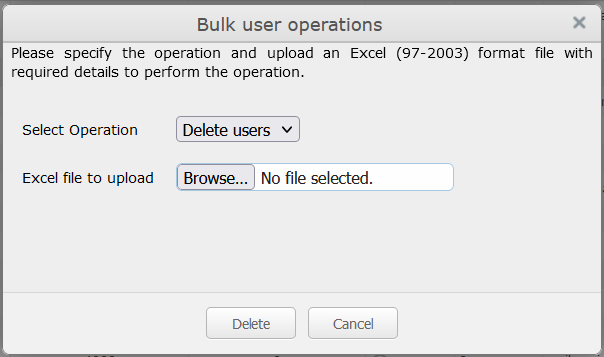 |
|
12 |
Click on Browse... button. Select the spreadsheet you have created. Click on Delete button |
|
13 |
The bulk deletion job will be added to queue and following is displayed. 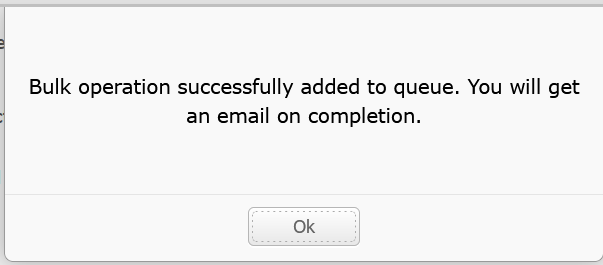 |
|
14 |
Click on OK. Old window will be displayed. Click on Cancel to close the Window. |
|
15 |
This operation will be completed in about an hour and on completion, you will get an email containing status of the operation. |
If many users are to be modified in a domain (say their passwords changed or forwarding set), modifying using the Web GUI may be time consuming and inefficient. In that case, Administrators can upload a spreadsheet containing the required data and modify the users. Follow these steps to modify users in bulk.
|
Sl No |
Description |
|
1 |
Create a spreadsheet in your favorite office suite. |
|
2 |
Enter data for one user in a single row. |
|
3 |
For each row, the columns should have the following data. There should be no header row. The first row should contain data of first user. Second row, data of second user and so on... |
|
4 |
Column 1: username Contains the email address of the user. Required. |
|
5 |
Column 2: name Contains name of user. Recommended |
|
6 |
Column 3: password Contains password of user. Optional. Password is required only for Email Storage Service and Non-Email services. If you have passwords in another system and want to migrate the same to HamaraCloud, same can be done. For migration, you can take the Password hash from the old system and give in password field. HamaraCloud supports
|
|
7 |
Column 4: alias Specify email address this is an alias of. Optional. Has effect only if Domain has Email Storage Service. |
|
8 |
Column 5: fwdemail Specify the email addresses to which incoming email for this mail box should be forwarded to. Multiple email addresses should be separated by , (comma). Optional. Has effect only if Domain has Email Storage Service. fwdemail and alias cannot both be specified for same user. |
|
9 |
Column 6: internal If this is an internal email address, specify 1, if not specify 0. Optional. |
|
10 |
Column 7: recipientbcc Specify the email address all incoming emails of the user has to be Bcc'ed to. Optional. |
|
11 |
Column 8: senderbcc Specify the email address all outgoing emails of the user has to be Bcc'ed to. Optional. |
|
12 |
Column 9: uploadnotifyemail Specify the email address to be notified if this user uploads any document using FTP/Web. Optional |
|
13 |
Save the Spreadsheet in Excel 97-2003 Workbook (*.xls) format. |
|
13 |
Make sure that the spreadsheet does not contain more than 1000 rows. If you need to create more than 1000 users, create multiple spreadsheets of 1000 users each. |
|
14 |
Once you are ready with the spreadsheet, proceed further |
|
15 |
Login to control panel |
|
16 |
That will bring up the following window  |
|
17 |
Click on Bulk Operations. That will bring up the following window  |
|
18 |
Choose Select Operation field as Modify users. That will display the following 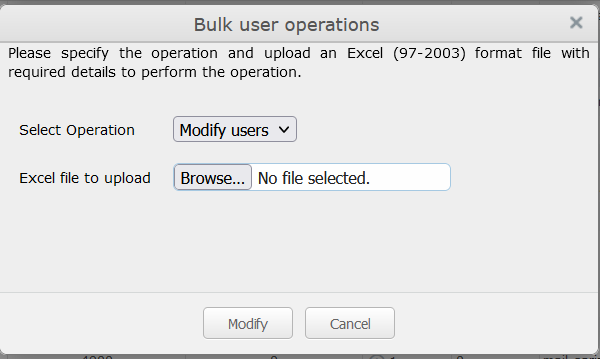 |
|
19 |
Click on Browse... button. Select the spreadsheet you have created. Click on Modify button |
|
20 |
The bulk modification job will be added to queue and following is displayed.  |
|
21 |
Click on OK. Old window will be displayed. Click on Cancel to close the Window. |
|
22 |
This operation will be completed in about an hour and on completion, you will get an email containing status of the operation. |
In certain cases (say when a user has left the organization), you may want to un-provision services for a user. Such services, can then be re-provisioned to different set of users. To un-provision service for a user, service has to be disassociated from the user. Follow these steps for the same.
|
Sl No |
Description |
|
1 |
Login to control panel. |
|
2 |
Search, if required and select the domain in which you want to un-provision a user by clicking the domain row. |
|
3 |
Click on View Users button |
|
4 |
That will bring up the list of users in that domain. |
|
5 |
Select the user (if required by searching for that user) you want to un-provision a service. Click on View Orders button. That will bring up the list of services associated with that user. An example is displayed below 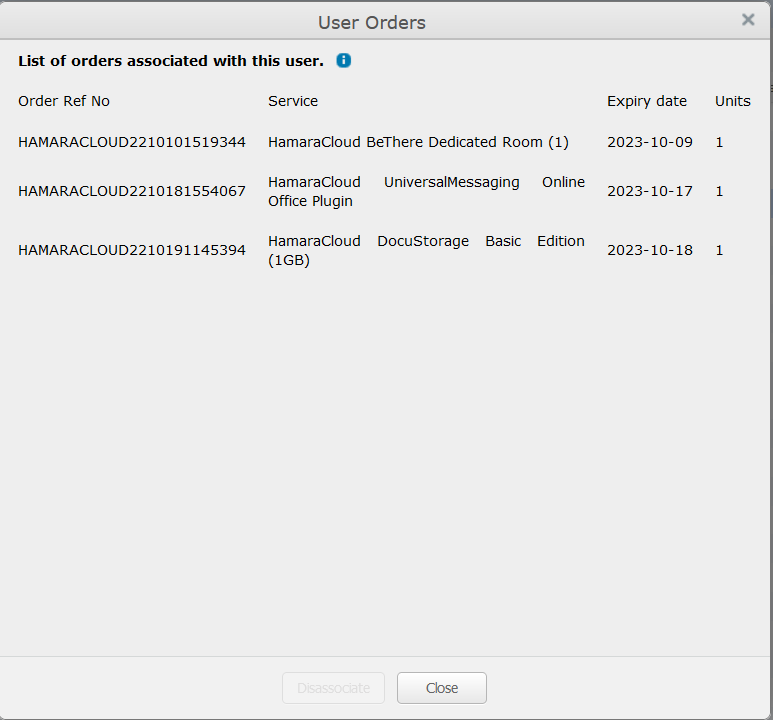 |
|
4 |
Select the order to un-provision by clicking on the order. It will display as follows  |
|
6 |
Click on Disassociate button. The service will be un-provisioned for the user |
|
7 |
The user can no longer avail the services. The order can now be re-provisioned for another user. |
|
8 |
Click on Close |
You can un-provision services for multiple users by creating a spreadsheet and uploading the same. Follow these steps for the same
|
Sl No |
Description |
|
1 |
Create a spreadsheet with two columns. |
|
2 |
For each row, the columns should have the following data. There should be no header row. The first row should contain data of first user. Second row, data of second user and so on... |
|
3 |
Column 1: Should have the username of user to who the particular service has to be removed. username will be the same as the email address of the user. This is required. |
|
4 |
Column 2: units should have the number of units of services to be removed from the user. For example if you specify 2 units of HamaraCloud UniversalMessaging Small Business Edition (1GB) to a user, she will end up with loss of 2GB of Email storage space. This field is required and should be an integer greater than zero. |
|
5 |
Make sure that the spreadsheet does not contain more than 1000 rows. If you need to create more than 1000 users, create multiple spreadsheets of 1000 users each. |
|
6 |
Save the Spreadsheet in Excel 97-2003 Workbook (*.xls) format. |
|
7 | |
|
8 |
Click on Invoices in left hand side. That will display the following  |
|
9 |
Your orders will be displayed in the Invoices grid. If there are too many orders, you can input the order number in the search field (displayed below) and press Enter  |
|
10 |
Select the order (which has to be un-provisioned) by clicking on the order, and Click on View Services button. That will display the services as follows  |
|
11 |
Click on the Service that you want to un-provision. That will display the grid as follows  |
|
12 |
Click on Disassociate User button. That will display the following 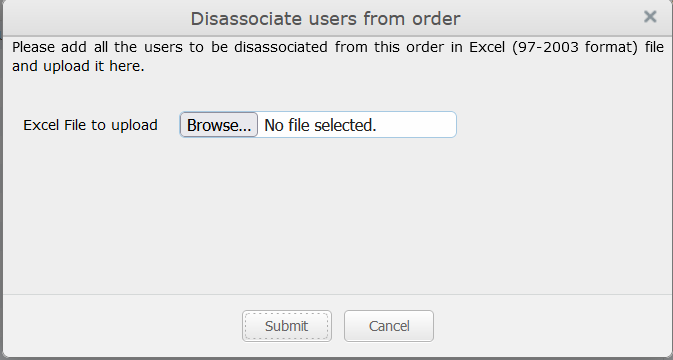 |
|
13 |
Click on Browse... button and select the created spreadsheet. |
|
14 |
Click on Submit button. The job will be submitted for execution and following displayed 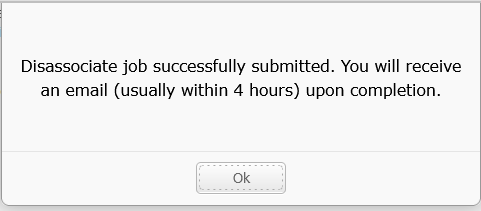 |
|
15 |
Click on OK. Old window will be displayed. Click on Cancel to close the Window. |
|
16 |
Upon successful execution, an email will be sent with the completion status of the process. |
|
17 |
This will un-provision the services for the selected users. The service, can then be re-provisioned for other users. |





